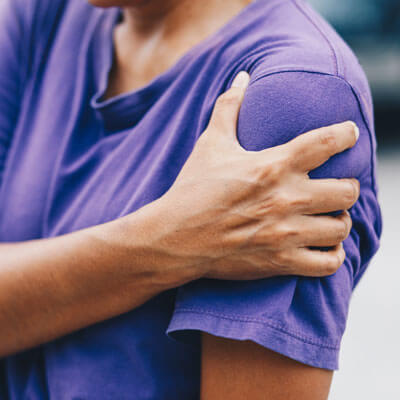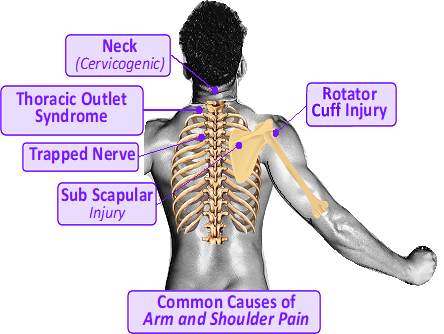Shoulder Pain Relief in Norwich
 Many clients onsult us for pain in the shoulder, neck and arm and chiropractic care can be an effective approach to restoring better function and facilitating faster healing. If left untreated many injuries develop into more complex problems.
Many clients onsult us for pain in the shoulder, neck and arm and chiropractic care can be an effective approach to restoring better function and facilitating faster healing. If left untreated many injuries develop into more complex problems.
How Adjustments Help
Chiropractic care can be very effective for shoulder pain and arm pain. When the normal function of the shoulder, neck and upper back is restored the body can heal.
Causes of Shoulder Pain
There can be many causes of pain in the shoulder, shoulder blade or arm:
- Nerve Pain: Referred to in different ways, damage to the nerves can refer pain, resulting in neck pain, shoulder pain, arm and hand pain. Other symptoms such as numbness, ‘dead arm’, throbbing, night pain and ache and pins and needles are often a sign of nerve injury. There are a number of different injuries that involve nerve referral pain including trapped nerves, spondylosis, thoracic outlet syndrome (TOS), rib pain, neuralgia, disc injuries (neck) and nerve root injury.
- Direct Joint Injury: The shoulder joint is actually a complex combination of several joints. These include the glenohumeral joint (proper shoulder joint), subscapular joint, acromioclavicular joint and sternoclavicular joint. The joint is also affected by rib orientation which allows the scapular (shoulder blade) its smooth gliding movement. These joints be injured directly, can become inflamed or can produce arthritis which limits movement and can be the source of pain. An advanced understanding of the joint biomechanics is important to be able to help restore good motion and to ensure long term healing.
- Muscle Injuries: The shoulder is supported by a complex interrelated muscle network that produces power for movement. In addition many of the shoulder muscles lock into position to provide stability or a pivot point around which motion can occur. As a result we have large powerful muscles such as the trapezius that move the whole shoulder joint and others such as the muscles of the rotator cuff that guide motion of the main moving muscles. These muscles can help stabilise the joint and provide changes to the angle of movement. As a result there are many points within the muscle structure where injury can occur. Knowing where the injury has occurred is helpful but equally important is the type of injury such as muscle tear, bruising, hypertonicity, muscle spasm, inflammation of the ligaments and so on.
- Bursitis: An inflammation of fluid sacs which help decrease friction, rubbing and irritation between muscles, tendons, bone and skin. Irritation can occur from repetitive impact such as repetitive lifting or from serious sudden trauma. This painful condition is often described as feeling similar to tendonitis.

Additional Causes of Pain
Irritation or injury to nerves in the upper back, neck and shoulders can result in weakness and numbness in the shoulder muscles and cause a sharp shoulder pain. Trapped nerves are very rarely ‘trapped’. Nerve irritation from chemicals released by trauma (such as those of the inflammatory cascade), muscle irritation and joint restriction or malposition are more likely to result in sensation associated with trapped nerves. These give the impression that the nerve is being squeezed. True trapped nerves are very rare and normally occur from disk compression, fractures, bony spurs, tumours or pathology. Chiropractic care can help with most symptoms that feel like a trapped nerve
The highly mobile shoulder joint is held in place by a ligamentous capsule. This collection of fibrous ligaments seals the joint but allows movement in certain directions, whilst limiting other motions which could result in dislocation. This provides the static stability of the shoulder joint when asleep or resting. Active stability of the shoulder is achieved when the powerful muscles of the shoulder lock the head of the humerus into the socket of the scapula. This allows the shoulder joints to arch through its range of motion. Frozen shoulder occurs when adhesions and hypertonicity build within the capsule, reducing ability to move the shoulder joint. It is associated with sudden severe pain on movement, “It just grabs me,” and by deep ache at other times, often at night.
The first rib is located high in the upper back underneath the collar. Ribs (T1-10) attach at the front, connecting directly or via cartilage connections, and at the back attach to the spine where they have two joints on each side. Pain from the joints at the back (costotransverse joints) is common and can feel like a knot under the shoulder blade or like an aching or pulled muscle. Pain may be referred along the costal nerves around the chest or down the arm. This pain is usually worse at night and can feel like a pulled muscle. It can be associated with pain on breathing and can often be mistaken for a heart attack. If you are unsure call 999. Rib injuries can be a cause of thoracic outlet syndrome (TOS). TOS can result in compression of the nerves, arteries or veins that exit the neck and travel over the upper ribs into the arm. The symptoms include neck, shoulder and arm pain.
Don’t Let Pain Hold You Back
If you have shoulder pain then call our experienced team to fast track your road to recovery.

